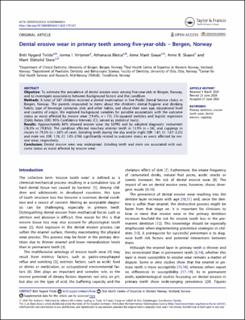Dental erosive wear in primary teeth among five-year-olds – Bergen, Norway
Virtanen, Jorma; Skeie, Marit Slåttelid; Tvilde, Britt Nygard; Bletsa, Athanasia; Graue, Anne Marit; Skaare, Anne B.
Journal article, Peer reviewed
Published version

Åpne
Permanent lenke
https://hdl.handle.net/11250/2736090Utgivelsesdato
2020-07-21Metadata
Vis full innførselSamlinger
Sammendrag
Objective
To estimate the prevalence of dental erosive wear among five-year-olds in Bergen, Norway, and to investigate associations between background factors and the condition.
Methods
A total of 387 children received a dental examination in five Public Dental Service clinics in Bergen, Norway. The parents responded to items about the children’s dental hygiene and drinking habits, type of beverage container, diet, and other habits, and about their own age, educational level and country of origin. We explored background variables for possible associations with the outcome status as worst affected by erosive wear (19.4%, n = 75). Chi-squared statistics and logistic regression (Odds Ratios (OR): 95% Confidence Intervals (CI), served as statistical tools).
Results
Approximately 80% showed erosive wear (by SEPRS and by adopted diagnostic instrument (78.5% vs 79.8%)). The condition affected maxillary anterior teeth in 13.9% (n = 54), and cuppings in molars in 79.3% (n = 307) of cases. Grinding teeth during the day and/or night (OR: 1.87, CI: 1.07–3.25) and male sex (OR: 1.76, CI: 1.05–2.96) significantly related to outcome status as worst affected by erosive wear, respectively.
Conclusion
Dental erosive wear was widespread. Grinding teeth and male sex associated with outcome status as worst affected by erosive wear.
